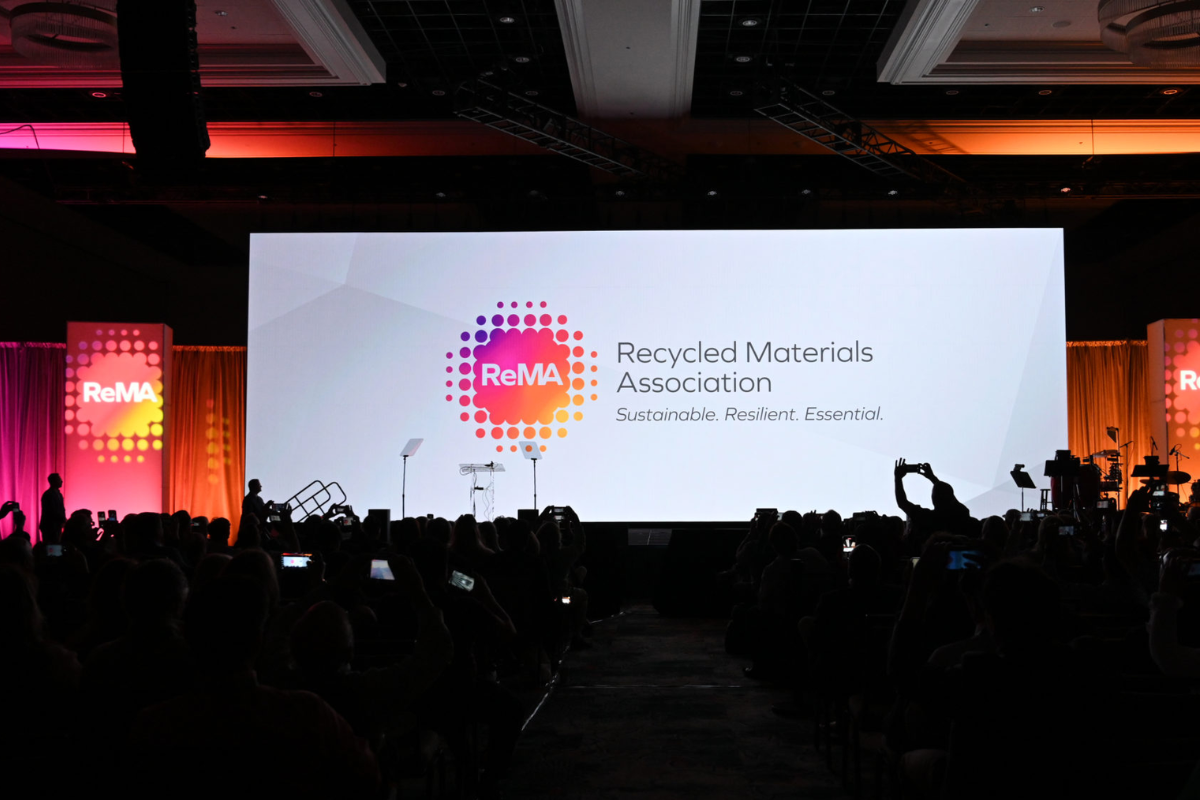
ISRI2024 brought together paper, plastics, electronics and metals recycling companies for four days of discussion on key industry topics, leading up to ISRI announcing its new name, ReMA. | Photo courtesy ReMA
Companies from across the materials recovery spectrum gathered at Mandalay Bay in Las Vegas last week for the ISRI2024 conference, which culminated in the long-running trade association unveiling a new name.
The Institute of Scrap Recycling Industries announced at the end of the April 15-18 conference that it will now be known as the Recycled Materials Association, or ReMA. In a presentation about the name change, leaders at the industry association said ISRI’s rebranding had its roots in a 2012 focus group convened by ISRI to gauge public perceptions of recycling.
“It was a pretty eye-opening event, and revealed to many of us that the public saw us in a very different way than we saw ourselves,” said Brian Henesey, the organization’s outgoing chairman, during the closing session of the conference.
The public image of recycling has evolved substantially since then and has taken an increasingly negative turn in recent years, said Michael Maslansky, CEO of Maslansky + Partners, which assisted with the rebrand. At the same time, government regulators were taking a stronger interest in recycling and brands increasingly came into the recycling space, sometimes overshadowing recycling operators themselves, Maslansky said.
“This industry was not getting the credit that it deserved,” he said. By 2022, ISRI’s leadership decided to explore a name change. One of the key goals was to focus on the outcome of recycling – material production – rather than the first step in the process, scrap recycling. The group also sought to respond to a public perception that scrap equates with junk, even if industry stakeholders don’t hold that same association.
In addition to the name change, ReMA has a new tagline: “Sustainable. Resilient. Essential.” In a statement on the rebrand, the organization said these terms reflect the environmental aspects of recycling, its contribution to a resilient economy and its importance in providing staple products used in everyday life.
Besides the rebrand, the four-day conference featured an array of sessions highlighting a range of materials recovery topics.
Among recycling sectors, plastics face a unique challenge
In a discussion of plastics recycling trends, speakers touched on factors challenging the industry and emphasized the need for government intervention.
Nina Bellucci Butler, CEO of Stina Inc., presented some takeaways from the annual U.S. Post-consumer Plastic Recycling Data Dashboard. The latest edition, covering 2022, was released in March. It showed the amount of plastics collected for recycling dropped by 70 million pounds in 2022.
The consulting firm has compiled the annual plastics recycling report for 15 years now, and looking at the results over time, “we can see we are not making the progress we should be making,” Butler said. For instance, the weight of plastic collected for recycling has fluctuated over the last decade, but in 2022 it was flat compared with 2013.
There is a positive trend in where recovered plastic is being processed. The 2022 report indicated the share of material going to domestic processors has increased: Similar to the paper market shuffling after China’s import restrictions, the plastics sector faced a few years in flux as a massive quantity of post-consumer plastic was shut out from export to China.
Then, in 2019, scrap plastic exports faced another hurdle with changes to the Basel Convention that added new regulations for shipping mixed plastics. Last year, scrap plastic exports hit a record low.
All of these factors helped keep more material in the U.S.: 94.7% of collected post-consumer plastic went to North American processors in 2022, versus 69.4% in 2013.
“That’s a positive trend that we’re seeing an overall increase in how much is being purchased, despite all of the headwinds that recyclers face,” Butler said.
Those headwinds include massive new virgin resin capacity coming online globally, U.S. reclaimers facing domestic supply shortfalls and looking to Canada for bales, and a surge in RPET imports making it difficult for domestic reclaimers to compete.
Scott Saunders, general manager of KW Plastics, said all of those trends will continue to challenge the plastics recycling sector. In particular, the onslaught of virgin material in the market will keep making it difficult for recycled resin to compete. Those factors are here for the foreseeable future, and the question is how the industry adapts.
Saunders identified two key tools to strengthen plastics recycling. First, he called for a focus on starting up more curbside programs. Growth in processing can only do so much without capturing more material at the household level to begin with.
“Unless that is expanded, the rate of recycling cannot grow,” Saunders said.
He was also blunt about the economics of plastics recycling and the need for policy intervention.
“It is not profitable to collect a plastic container from the home without something, something spurring that along,” Saunders said. That means either the consumer is paying a fee for curbside recycling or a deposit on the product at point of sale, or the producer is paying the cost to recycle the product.
The latter policy, extended producer responsibility, is in development in four U.S. states. That policy is in its infancy, he noted, and it remains to be seen how it will play out for plastics reclaimers. But policy in some form is a must, Saunders said, noting that fact sets reclaimers apart from other recycling sectors, like metals, where processors can rely on the economic value of the recovered material to make the process profitable.
“It takes some interaction between a government entity and the consumer, and that is where we’re totally different from the rest of the ISRI membership,” he said.
A version of this story appeared in Resource Recycling on Apr. 23.